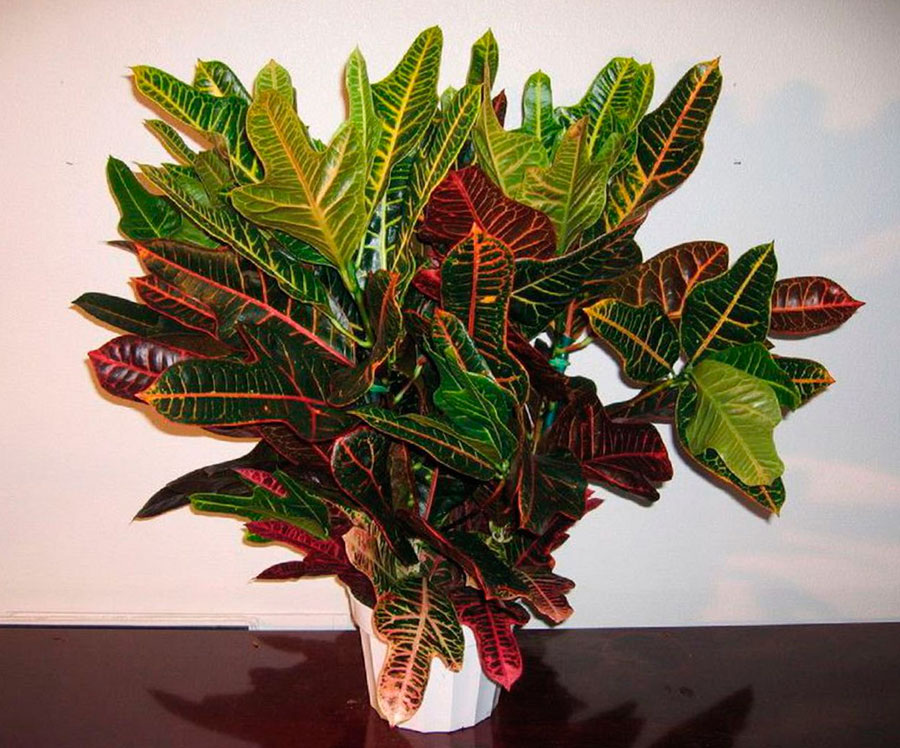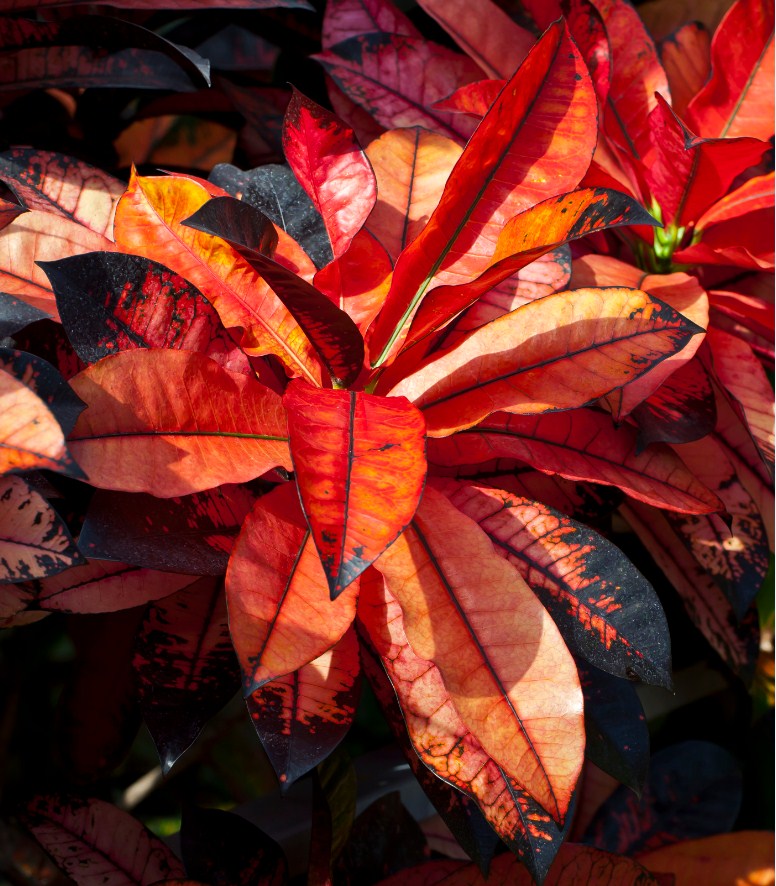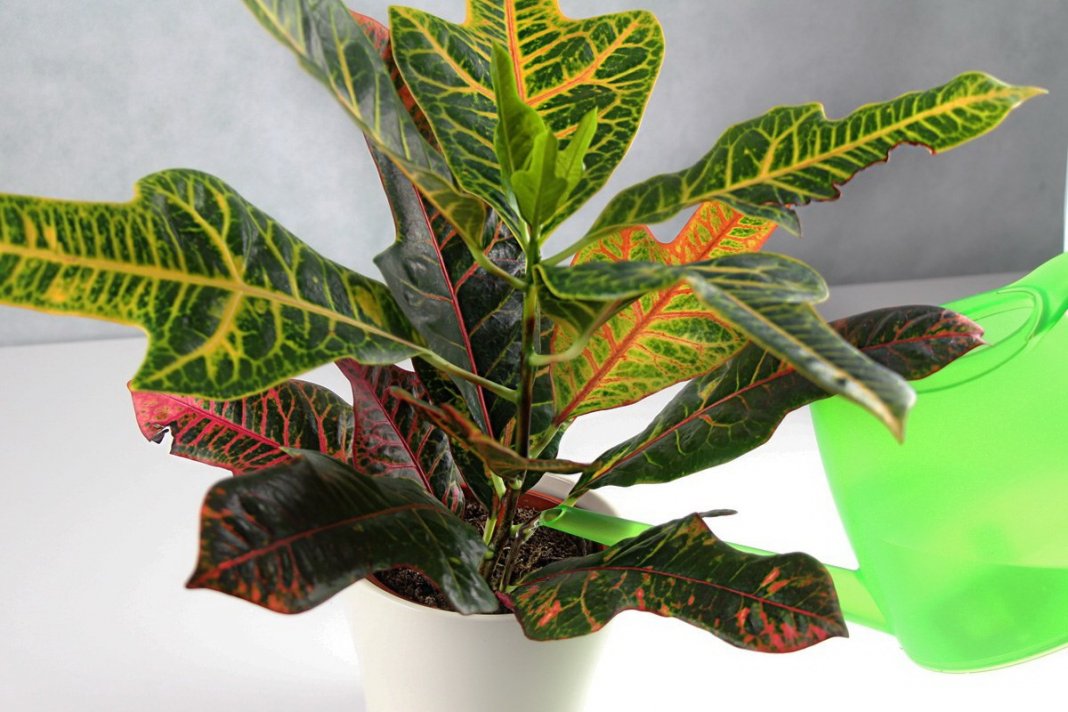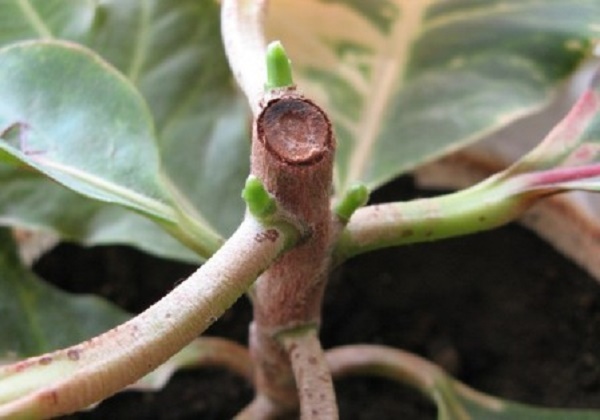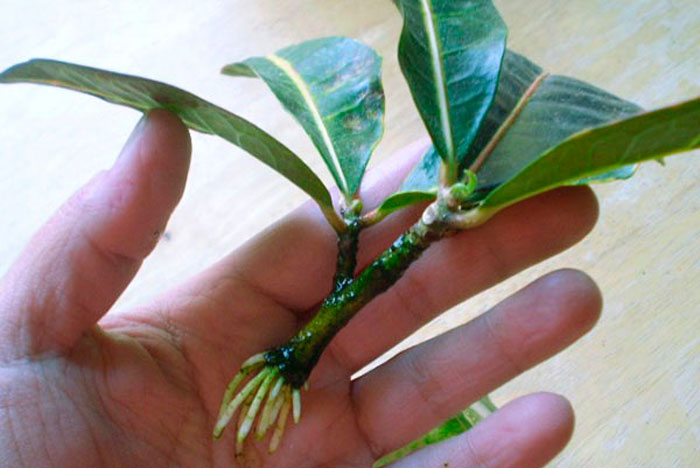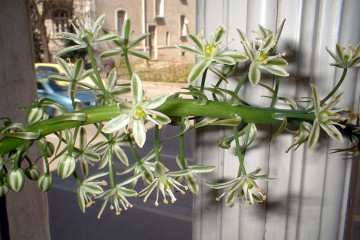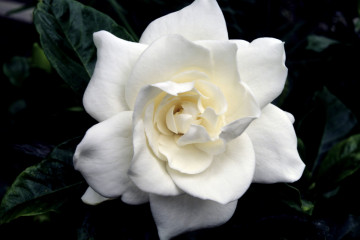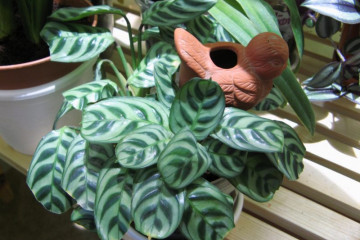Codiaum (croton) - houseplant with green leaves and yellow spots
Content:
Croton, or the popular name - codiaum, is a beautiful and variegated houseplant of the Euphorbia family. There are many varieties of this plant, some leaves resemble in their shape an oak leaf or willow foliage. By color, you can also find many options: dark green, burgundy, yellow and red.
About the history of appearance
The Malacca Islands are considered the birthplace of codiaum. Under natural conditions, it grows as a bush and grows up to 3 meters, at home - its growth is half as much. Young leaves grow green, but as they age, they acquire multi-colored colors.
Compared with other varieties and varieties, the codiaum "Brik", "Zanzibar" and "Petra" began to spread relatively recently in the houses and apartments of Russians. The unusual color of the leaf plate is finding more and more people who want to breed this plant.
An indoor plant with green leaves with yellow spots appeared in European homes in the early 19th century. For a long time, experts studied a new plant, conducted breeding experiments, making a step-by-step description of each action, which eventually resulted in a large number of new species and varieties.
Common varieties
Since the 19th century, variegatum has been grown as a houseplant - the only croton known at that time, species and varieties with various colors became known many years later.
Excellence
Fine oaky codiaum A tree with a strict crown structure, which forms one central trunk. The flower codiaum Excelent has large leaf blades that are located along the shoot, resembling a tiled structure. In the upper part of the trunk, the leaves are of a more intense color: from a greenish-yellow tone to a red-burgundy one. Down at Croton Excelent, the leaves are greener, with pronounced light-colored veins.
Variegatum
Its other name is widespread among the people - "decorated". Today, codiaum variegatum can be found in the wild in China. Landscape designers in this country prefer to use it as a landscaping material in Beijing to create a unique atmosphere. It can also be found in Pakistan. The plant can grow up to 2.5-3 meters in height. The trunk is formed at the bottom bare, at a height of 10-20 cm, the first leaves begin to appear. They have an elongated lanceolate shape and are ovoid at the base. The color is dominated by green and brown tones. Due to the fact that many cannot accurately determine the name of the variety or species, the name Croton or codiaum motley is most often used by the people.
A variation of this interesting representative is the codiaum Variegatum Mix. There is no exact data about which species the croton belongs to. Bright, wavy, slightly curled leaves add more character to this tree.
Another representative of the codiaum variegatum was the Moluccan variety. The leaves are wide downward, narrower upward, slightly ovoid. There is also the Minus variety, which has fully elongated thin leaves.
The genoa form of the plant has flat, wide lanceolate leaves. They taper towards the base. An unusual pattern of golden and silver colors can be observed on the surface of the plate, sometimes such a picture takes on a reddish tint.
Mummy
Croton Mummy is a bright plant with multi-colored leaf plates, which are very densely located along the shoots. In a young plant, the leaves are yellowish-green, the older croton changes its shade to red, then to red-brown. A very old plant may have completely black leaflets. A feature of the variety is the shape of the leaf plate, which is slightly twisted during the growth process. Some leaves can curl so much that their reed (original) shape is completely lost.
Mrs. Ayston
Croton Mrs. Aiston has a large number of admirers. It is an interesting variety due to the unusual shape of the leaf plate. The leaves are broad, rounded at the ends, flat. Young trees have a soft creamy tone of the plate, while older ones begin to acquire speck of various shades: from pink to red and yellow. The spotted flower becomes brighter with age, which makes the plant look more interesting.
There are several varieties of this variety:
- Aiston codiaum red. A plant with red or dark red leaves, leaf plates downward can be completely black.
- Aiston yellow. His leaf plates are completely yellow, may be orange.
- Codiaum Disraeli. Green-red leaves with yellow veins.
- Black Prince. Variety with green leaves with red and yellow spots.
Croton narrow-leaved
Narrow-leaved codiaum - the owner of long, up to 20 cm, with very thin leaves. On the green base, bright spots of yellow or red hue can be located. Among the representatives of this species is Croton Piktum Spot. The thin-leaved flower resembles a palm tree with brightly colored variegated leaves.
Codiaum aucubol
A wonderful plant that will decorate any home. The leaves of the tree are green with yellow fragments, but the color is unevenly distributed over them. Bright and dimmer shades can be observed on one sheet.
Features of home care
Croton is quite unpretentious in care. It can live well in the shade, but the best place to stay is the sunny side with diffused light. It is better to refuse places with direct rays of the sun, as the leaves will get burned.
Temperature
The ideal temperature for croton is 20-24 degrees Celsius. Extremely low temperatures cause root rot and leaf fall.
Watering
Watering the flowerpot is carried out as the soil surface dries up. In winter, croton is watered even less often.
Spraying and maintaining moisture
Croton needs high humidity. Therefore, he needs daily spraying. It can be rinsed with a shower once a week.
Priming
Croton soil can be purchased at a flower shop or made by yourself. For home soil you will need:
- leafy soil (1 part);
- sod land (2 parts);
- rotted manure (1 part);
- peat (1 part);
- river sand (0.5 parts).
Before use, 2 parts of charcoal are added to the finished mixture. It acts as a disinfectant in the mixture.Additionally, before sowing, spill with a solution of potassium permanganate.
Top dressing
You can fertilize the flowerpot in the spring and summer. In winter - once a month, in spring-summer - once a week. In no case should you water the fertilizer on the dry soil of the flowerpot. The pot is preliminarily watered with plain water.
Pruning
It is necessary to care for Croton throughout his life. The main point in leaving is pruning.
The value of pruning in home care:
- Plant formation;
- Awakening the flower to growth;
- Stimulating the tree for laying side shoots;
- Renewal of the vegetative part;
- Removal of damaged parts of the codiaum.
It is necessary to carry out the circumcision procedure with a new, clean and sharp knife.
Before using the knife, it must be treated with alcohol or fungicide. This is to prevent disease from occurring after pruning. The place of the cut is sprinkled with charcoal crushed to a powder state, left for a while to dry out. Cannot be treated with any antiseptic agents for 7-9 days after the procedure.
In addition to the main pruning procedure, flower stalks and buds are also removed. Caring for the cut sites is the same.
How does it multiply
Reproduction can take place by seeds and cuttings. The plant is rarely propagated by seeds, an easier way is vegetative propagation by cuttings.
Germinating seeds
This is the main breeding method for hybrid Croton Mix. It is used for the reason that if you use the vegetative method, there is a chance that the new plant will lose its varietal properties. Only fresh seeds that have been harvested in the current season are suitable for sowing.
The seeds must first be soaked for a day. The water should be heated to 60 degrees. In a day, when the seeds are swollen, they can be sown into the substrate. The sowing depth should be no more than 1 centimeter.
For germination, it is necessary to maintain the indoor temperature within the range of 20 to 21 degrees. Crops should be watered only by pouring warm water into special trays.
After the appearance of at least 3 leaves in young plants, a pick is carried out, each seedling is planted in a separate container.
Rooting cuttings
Cutting cuttings is best done with gloves, since poisonous milk flows out of the plant at the cut point. If it gets on soft tissue, it can cause burns. It should be rooted in a moist substrate. Rooting occurs in 1-1.5 months.
In order for the roots to grow faster, a minimum of leaves are left on the stem, then the plant will direct all its energy to the root.
Air layering
A less common type of propagation, but also used by flower growers. The sheet is fixed to the soil with a special clothespin, and it is sprinkled with soil from above at the point of contact with the ground. Caring for a plant with a "clothespin" is the same as for another member of the family.
It is periodically necessary to check whether the cut has taken root. The first roots on the clothespin will begin to appear in 2-4 weeks.
Transfer
The transplant is carried out as the croton grows, this is about once every 1.5 years. For him, like any other indoor plant, the pot is chosen a little more than the previous one. The soil for the plant in the store becomes universal. It is also advisable to buy drainage.
Possible growing problems
Leaves turn pale
The leaf plate loses its color if there is very little consecration in the room.
Transparent or light spots on the leaves
The leaf plate may completely lighten (become almost white), or pale spots appear on it. This is the first sign that the plant is in an overly lit area. Also, from drafts, such a reaction can occur in croton.
The tips of the leaves dry
The dried tips of the flower or the spots of a brown tint that appear throughout the leaf blade indicate that it is very dry in the room, or the plant is being watered in insufficient quantities. Sometimes the tips can dry out from the fact that the codiaum is very cold in the apartment.
The lower leaves fall
This is a natural process in an adult plant. Croton with age, stretching out, sheds the lower leaves, so there is no reason to worry about this.
Pests
The main enemy of the flowerpot is the spider mite. The backs of the leaves should be checked every 10 days. If there is even a subtle hint of the presence of a tick on the leaf plate, you should spray it immediately with an insecticide or prepare the medicine yourself. For this, a soap solution is made from dark laundry soap. Leaves and stem are wiped with a moistened cotton pad. Such actions should be repeated 3-4 times after five days.
Croton is quite picky about care, it periodically requires a rest period. For example, codiaeum Excelent when caring at home can darken and shed almost all the leaves if the tree is not properly taken care of.
Video
